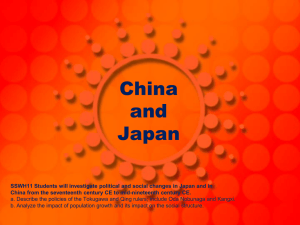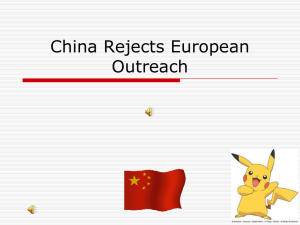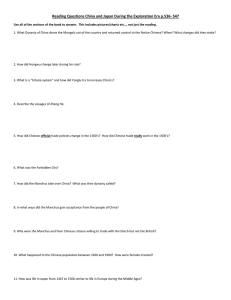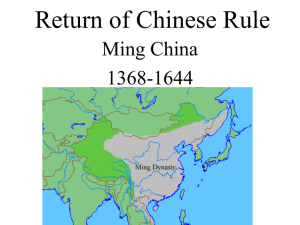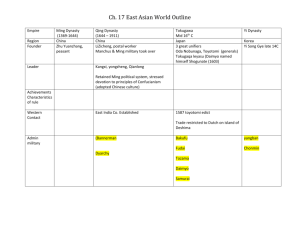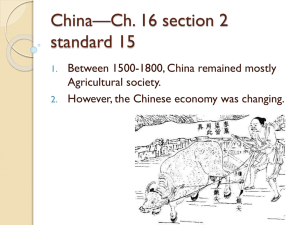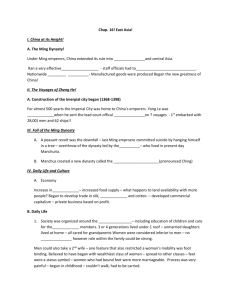APWH Ch 16 Ming China and Tokugawa Japan (pgs. 369-370)
advertisement
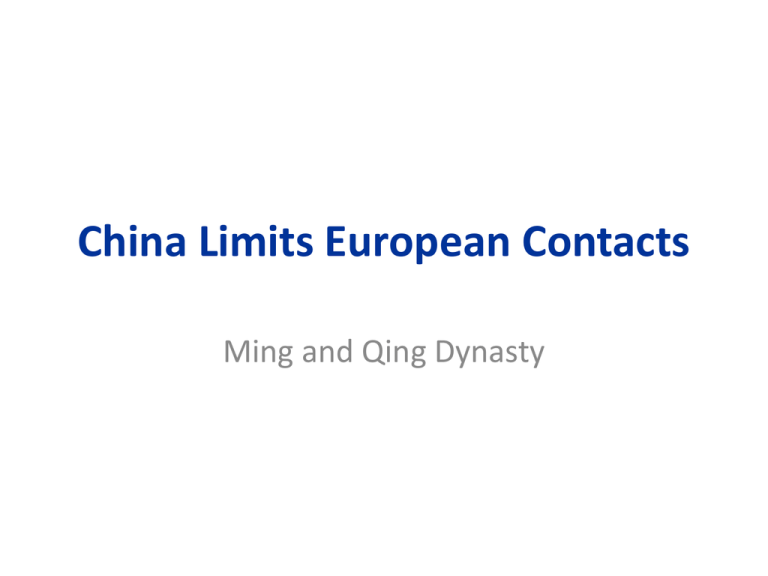
China Limits European Contacts Ming and Qing Dynasty China Under the Powerful Ming Dynasty • A New Dynasty – Ming dynasty—rules China from 1368 to 1644 – Ming rulers collect tribute from many Asian countries • The Rise of the Ming – Hongwu—peasant’s son who leads army that forces Mongols from China – First Ming emperor, he begins agricultural and government reforms – His son, Yonglo, becomes next emperor; moves royal court to Beijing – In 1405, he launches first of voyages of exploration • The Voyages of Zheng He – Chinese admiral Zheng He (pronounced Jung Huh) leads seven long voyages with 400 ships per voyage – Distributes gifts to show China’s superiority • Ming Relations with Foreign Countries – In 1500s, Chinese government controls all contact with outsiders – High demand for Chinese goods helps China’s economy prosper – Government policies favor farming over manufacturing and merchants – Christian missionaries bring European ideas to China Zheng He The Chinese Columbus (only more successful) Manchus Found the Qing Dynasty • Another New Dynasty – Manchus—people of Manchuria, in northern China – Qing dynasty—Manchu rulers who take control of China in 1644 • China Under the Qing – Chinese resent rule by non-Chinese, often rebel – Manchus later gain acceptance through able rule – Kangxi—emperor from 1661 to 1722—reforms government, promotes arts – Qian-long—emperor from 1736 to 1795—expands Chinese empire • Manchus Continue Chinese Isolation – Chinese think themselves culturally superior to other peoples – Set special rules for foreign traders to follow – Dutch accept these rules; British do not and are blocked from trade • Korea Under the Manchus – In 1636, Manchus conquer Korea – Korean people gradually develop feelings of nationalism – Art reflects rejection of Chinese ways Kowtow • Would you do ------this For These? ------- Life in Ming and Qing China • Families and the Role of Women – New farming techniques produce more crops, spur population growth – Families favor sons over daughters – Some women work outside home, but most live restricted lives • Cultural Developments – Culture based on traditional forms – Dream of the Red Chamber (literary work) reveals Manchu society – Plays about China’s history help unify Chinese people Japan Returns to Isolation • A New Feudalism Under Strong 1480 to 1600 Local Lords Rule Leaders Gekokujo (bottom overthrowing the top) – In 1467, civil war destroys old feudal system in Japan – Period from 1467 to 1568 is called time of the “Warring States” – Daimyo—warrior-chieftains—are lords in new feudal system – Emperor is figurehead with no real power – Daimyo build armies of mounted samurai and gun-bearing infantry • New Leaders Restore Order – Oda Nobunaga (1534-1582)—powerful daimyo who seizes capital of Kyoto in 1568 – Nobunaga tries to eliminate rival daimyo and Buddhist monasteries – In 1582, commits suicide when an ally turns against him – General Toyotomi Hideyoshi (1536-1598) carries on Nobunaga’s work – By 1590, controls most of Japan – Launches invasion of Korea, but effort ends when he dies • Tokugawa Shogunate Unites Japan – Tokugawa Ieyasu (1542-1616) takes over, completes unification of Japan – In 1603, becomes shogun, or sole ruler – Sets up capital at Edo, which grows to be Tokyo – Uses restrictions to keep daimyo under control – Tokugawa Shogunate rules Japan from 1603 to 1867 "The reunification is a rice cake. Oda made it. Hideyoshi shaped it. At last, only Ieyasu tastes it." Life in Tokugawa Japan • Society in Tokugawa Japan – Long period of peace, prosperity, cultural growth – Structured society, with shogun as actual ruler – Confucian ideas influence society – Peasants suffer from high taxes; many leave farms for cities – By mid-1700s, Japan becoming urban society – Most women lead sheltered lives 4 classes (from top to bottom): Samurai: warriors for the shogun Peasant: workers and farmers Artisan: craftsmen Merchant: traded crafts for money and rice Outsiders were called “eta” and they were people whose jobs dealt with death (i.e. tanning hides) • Culture Under the Tokugawa Shogunate – Traditional culture thrives – Tragic noh dramas popular among samurai – Townspeople enjoy new type of realistic fiction – Many people enjoy haiku—three-line poetry that presents images – Kabuki theater—skits with elaborate costumes, music, and dance Samurais had a code of honor called Bushido. They were supposed to be honorable, frugal, and valiant. Seppucku: ritual suicide for a failed samurai Contact Between Europe and Japan • Portugal Sends Ships, Merchants, and Technology to Japan – In 1540s, European traders begin arriving; welcomed by Japanese – European firearms change Japanese way of fighting Tokaido Road • Christian Missionaries in Japan – In 1549, first Christian missionaries arrive – By 1600, about 300,000 Japanese are Christians – Japan’s rulers upset by this, ban Christianity – After 1637 rebellion, Christianity is forbidden in Japan The major road connecting Kyoto and Edo Became popular for merchants and traders Led to the rise of the merchant class The Closed Country Policy • Growing Tensions – First Europeans arrive when Japan has no central authority – Shoguns, who later take power, dislike European ideas, ways of life • Japan in Isolation – Shoguns limit European trade to port of Nagasaki – Only Dutch and Chinese are allowed to trade; shoguns control trade – Japanese people are forbidden to travel abroad – Japan develops in isolation Journal Write a Haiku about one of the leaders we discussed today (Oda, Toyotomi, or Ieyasu) A Haiku has 3 lines: first line has 5 syllables second line has 7 syllables third line has 5 syllables Sample Haiku: The Rose by: Donna Brock The/ red / blos/som bends/ (5 syllables) and/ drips/ its/ dew/ to/ the/ ground / (7 syllables) Like/ a/ tear/ it/ falls/ (5 syllables)

